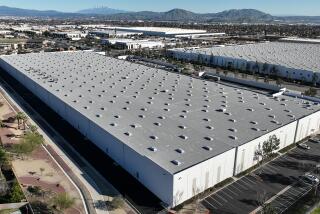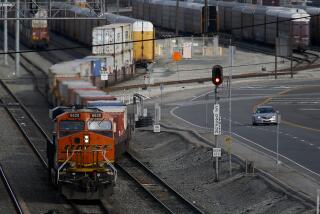State Seeking Ways to Speed Cargo
The Schwarzenegger administration is briskly completing an ambitious but controversial plan to boost cargo shipments throughout California while curbing toxic air pollution from ships, trucks and trains.
The plan could affect the number of trucks on Los Angeles and Bay Area freeways, the growth of cargo-related jobs in the Inland Empire and Central Valley, and the amount of air pollution along freeway and rail corridors statewide.
State officials hope to finish the plan in December so it can be included in Gov. Arnold Schwarzenegger’s State of the State address in January. It may also be a topic during his trade mission to China in mid-November.
Business and community interests are divided on the project, with many shippers applauding it as a sorely needed blueprint to increase trade and ease traffic congestion.
Critics, however, say the administration is ramrodding the plan through without sufficient study of how air pollution currently affects residents near the state’s freeways, ports and rail lines.
The debate underscores California’s growing stature as the largest U.S. entryway for Asian imports arriving by ship and transported across the country by trains and trucks.
The plan will establish how California’s transportation network can be expanded and improved to speed cargo movement and prevent bottlenecks. It will also outline financing strategies and ways to rein in air pollution.
In a letter Friday, the executives of the state’s two leading smog-fighting agencies and several environmental groups appealed to state officials to roll back the December deadline so that health concerns could be studied more thoroughly.
The back-and-forth is expected to continue this week in a series of public meetings today through Friday in Sacramento. In coming weeks, officials will review $47.3 billion in potential construction projects -- including highways, bridges and rail yards -- and choose those they believe are most needed to ease traffic congestion and ensure the smooth flow of cargo.
The list will pinpoint “the things that are really important to do, that we need to do, sooner rather than later,” said Barry Sedlick, undersecretary at the state Business, Transportation and Housing Agency, which is charged with crafting the plan in tandem with the state Air Resources Board.
“This plan is overdue,” said T.L. Garrett, vice president of the Pacific Merchant Shipping Assn., adding that anyone who drives Los Angeles freeways “realizes we’ve neglected our infrastructure far too long.”
But in the Friday letter, critics assert that planners are moving too quickly.
“We need a clear response that expansion of the goods movement system will be linked to implementation of a comprehensive mitigation plan to fully address community, environmental and health impacts,” states the letter, co-signed by Barry Wallerstein, executive officer of the South Coast Air Quality Management District, and Jack Broadbent, executive officer of the Bay Area Air Quality Management District, along with leaders of several environmental groups.
The letter contends that working groups reviewing the plan are heavily stacked in favor of industry, and that public health scientists and community groups should be represented.
At a meeting Saturday in Los Angeles, Melissa Lin Perella, a staff attorney at the Natural Resources Defense Council, urged the state to make public a long-awaited assessment of how cargo transport currently affects public health in the Los Angeles area.
The council and other clean-air organizations have asserted that the Schwarzenegger administration has withheld that assessment for months
Mike Scheible, deputy executive director of the state air board, said Saturday that the agency’s staff would produce “at least a draft” of a comprehensive health assessment by the end of November and hoped to follow in mid-December with a draft plan for reducing air pollution. Critics say that is too late for meaningful review.
A related air board report released in early October found that diesel fumes generated within the boundaries of the ports of Los Angeles and Long Beach are elevating the risk of cancer as far as 15 miles inland. The study did not account for pollution from trains and trucks outside the ports. Diesel fumes, which are carcinogenic, have also been linked to lung ailments such as asthma and to heart disease.
State officials say their goods movement plan will include ways to reduce emissions to 2001 levels by 2010 and to then impose further cuts.
The so-called goods movement industry supports one of every seven California jobs and contributes more than $200 billion annually to the state economy, says the first part of the plan, released in September by the state Business, Transportation and Housing Agency and the state Environmental Protection Agency.
The boom in imports from Asia is expected to continue, with shipments of cargo containers projected to double by 2015 and perhaps even triple by 2025, the report states.
Business leaders say highway expansion and other projects are sorely needed to maintain California’s role as a juggernaut of global trade.
They point to the infamous cargo jam in fall 2004 at the ports of Los Angeles and Long Beach, the nation’s two largest container ports. A confluence of problems such as labor and rail car shortages caused dozens of ships to wait in line offshore, a financial fiasco that stirred concern in China and other Asian countries.
The new plan could help California obtain more federal transportation funds because it would identify the most important projects for cargo movement, rather than having a barrage of interests fend for themselves, some officials said.
“We need to speak with one voice,” said Arthur B. Goodwin, planning director at the Alameda Corridor Transportation Agency. He said that in Washington, “They don’t understand what ‘No. 1’ is, because they hear about ‘No. 1s’ from everybody.”
The cargo boom has been blamed for increased levels of diesel particulate matter and nitrogen oxides, which recent health studies have linked to health problems such as stunted lung growth in children in highly polluted areas of Southern California.
Those studies have caused concern among residents near the Los Angeles-Long Beach port complex and along truck corridors and rail yards as far east as San Bernardino County. Similar concerns have surfaced in neighborhoods near the Port of Oakland, the state’s third-largest seaport.
Public meetings on the plan will begin at 9 a.m. today and continue all week at Cal-EPA headquarters in Sacramento. More information and webcasts are available at the air board website, www.arb.ca.gov.
Other meetings on the plan are set for 10 a.m. Saturday at the Faulkner Gallery in Santa Barbara and 10 a.m. Nov. 12 at Central Park Senior Citizen Center in Rancho Cucamonga.
More discussion is expected Friday when the board of the South Coast Air Quality Management District holds a special meeting in Long Beach to report on the scope of port-related air pollution, discuss potential solutions and hear from the public. The meeting will begin at 9 a.m. at Long Beach City Hall.
More to Read
Get the L.A. Times Politics newsletter
Deeply reported insights into legislation, politics and policy from Sacramento, Washington and beyond. In your inbox three times per week.
You may occasionally receive promotional content from the Los Angeles Times.










